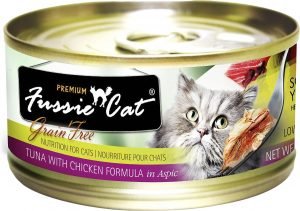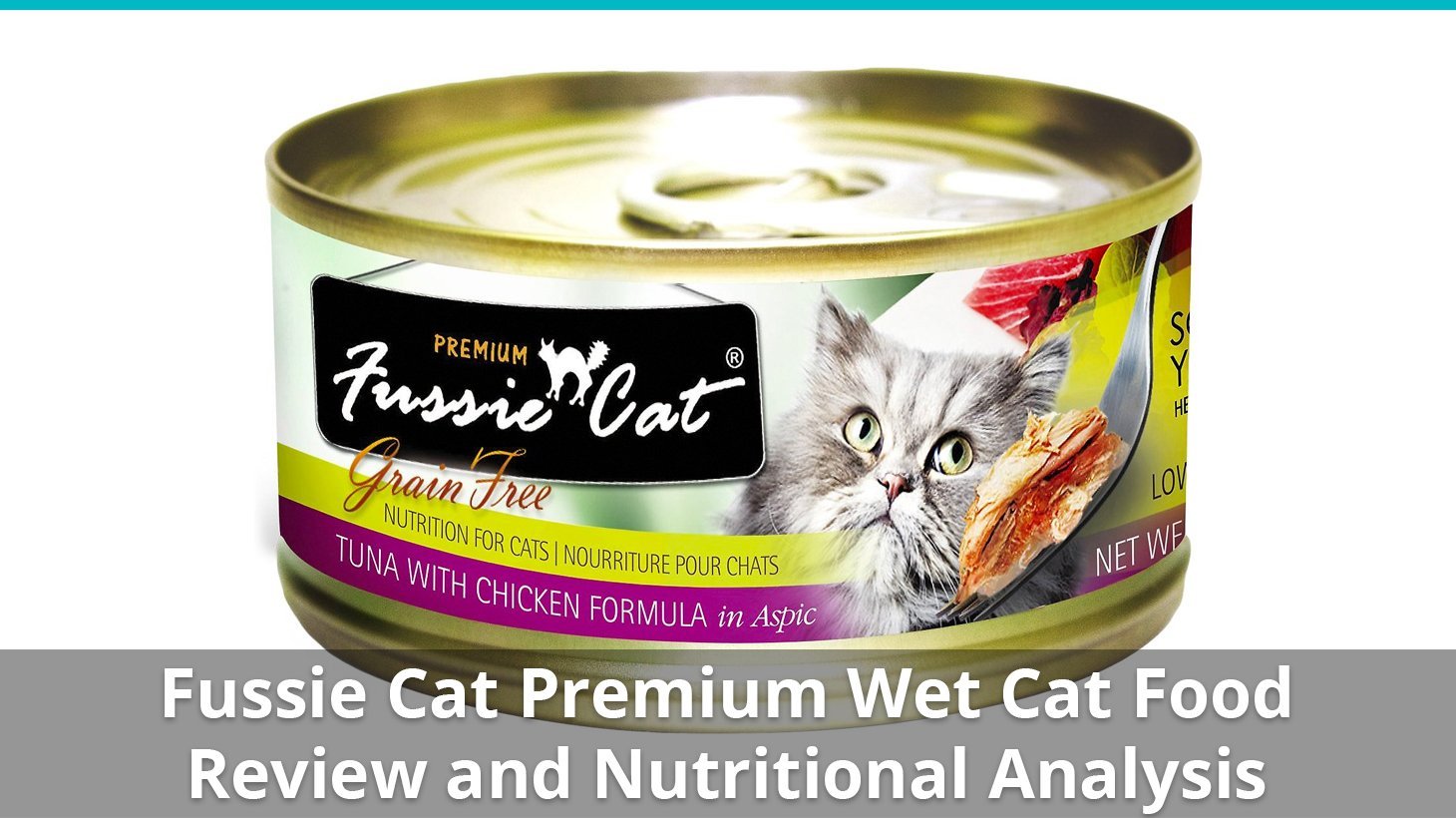Our review process is unbiased and based on extensive research. If you buy through the links on our site, we may earn a commission.
Rating
- Meat is the first ingredient – 1 Star
- Uses some unnamed meats – 1 Star
- Above average protein content – 1 Star
- Less than 4 controversial ingredients – 1 Star
- Catological Discretionary Rating – 0 Star
Here’s a few important points:
- Meat is the first ingredient
- They only have fish-based recipes – we do not recommend feeding a mainly-fish-based diet
- No fillers are used, although multiple thickening/gelling agents are used
- They are very protein-heavy, but we’d like to see a bit more fat
- The 4 star rating is somewhat misleading, as we still do not wholly recommend this food, since cats should not eat a fish-based diet
Fussie Cat’s Premium product line includes 12 wet recipes/flavors.
Each recipe below includes its related AAFCO nutrient profile when available on the product’s official webpage or packaging: Growth (G), Maintenance (M), All Life Stages (A), Supplemental (S) or Unspecified (U).
The star rating is a rough average of all of the flavors in a single line of food. If an individual recipe scored lower or higher, we will mark that below, next to the flavor.
- Fussie Cat Premium Tuna with Salmon (A)
- Fussie Cat Premium Tuna with Chicken (A)
- Fussie Cat Premium Tuna with Ocean Fish (A) 3 stars
- Fussie Cat Premium Tuna with Shrimp (A)
- Fussie Cat Premium Tuna with Prawns (A)
- Fussie Cat Premium Tuna with Anchovies (A)
- Fussie Cat Premium Tuna with Mussels (A)
- Fussie Cat Premium Tuna (A)
- Fussie Cat Premium Tuna with Clams (A)
- Fussie Cat Premium Tuna with Smoked Tuna (A)
- Fussie Cat Premium Tuna with Threadfin Bream (A)
- Fussie Cat Premium Tuna with Chicken Liver (A)

Fussie Cat Premium Tuna with Chicken was selected to represent the other products in the line for this review.
Fussie Cat Premium Tuna with Chicken
Wet Cat Food
| Estimated Nutrient Content |
| Protein | Fat | Carbs | |
|---|---|---|---|
| Guaranteed Analysis | 12% | 2.5% | NA |
| Dry Matter Basis | 77% | 16% | 3% |
| Calorie Weighted Basis | 65% | 33% | 2% |
Estimated Dry Matter Nutrient Content
Fiber (guaranteed analysis)
0.1%
Calories/100g
61
Is real, named meat the first ingredient?
Yes
Ingredients
Tuna, Water Sufficient for Processing, Boneless Chicken, Sunflower Seed Oil, Tricalcium Phosphate, Locust Bean Gum, Carrageenan, Guar Gum, Potassium Chloride, Choline Chloride, Fructooligosaccharide, Taurine, Zinc Sulfate, Vitamin E, Supplement, Ferrous Sulfate, Thiamine Mononitrate (Source of Vitamin B1), Nicotinic Acid (Source of Vitamin B3), Calcium Pantothenate, Vitamin A Supplement, Potassium Iodide, Manganese Sulfate, Copper Sulfate, Vitamin D3 Supplement, Riboflavin Supplement (Source of Vitamin B2), Pyridoxine Hydrochloride (Source of Vitamin B6), Folic Acid, Menadione Sodium Bisulfite Complex, Vitamin B12 Supplement.
Ingredients in red are controversial or of questionable quality.
Ingredient Breakdown
The first ingredient in this cat food is tuna. OK, but with reservations.
Cats may love tuna, but tuna is not the best choice for your kitty.
While it is a good, lean protein that contains healthy fatty acids, it is higher in mercury than most other fish.
The mercury in tuna may be more likely to affect your cat than it would a human, since cats are likely to ingest more on a bodyweight to food ratio.
While a little treat now and then likely won’t hurt, there’s no reason to feed your cat tuna as it’s main protein source, when chicken or rabbit options are plentiful.
Cats may also have allergies to fish, not to mention they don’t typically eat it in the wild.
After water, the second ingredient is boneless chicken. Good.
While quality of the individual ingredient can vary, chicken is a very good protein source for cats.
It’s also important to note that chicken contains about 70% water, so when it is processed and cooked for use in cat food, it will become a smaller part of the total recipe.
The third ingredient is sunflower seed oil. Good.
This is a decent source of fat for energy and potentially for a healthy coat.
Some prefer meat-based fats, like chicken fat, but sunflower seed oil is not bad.
The fourth ingredient is tricalcium phosphate. Good.
Tricalcium phosphate is both a useful phosphorous supplement to help regulate acidity in the body, and an emulsifier.
It helps the food stay together a bit more in general, but without “caking” or “clumping”.
The fifth ingredient is locust bean gum. OK, but with reservations.
This is a non-nutritive binder / gelling agent.
There are reports that it could possibly be dangerous in high quantities, and may be bad for the gut, though scientific studies are needed to confirm these claims.
Like with anything, it appears that very high doses could be harmful, but there is likely not near enough in this recipe to cause worry.
The sixth ingredient is carrageenan. Bad.
It also uses carrageenan, another thickening agent.
Carrageenan is a very controversial ingredient. It is derived from a red seaweed.
One of it’s forms, degraded carrageenan, is a potential carcinogen.
While degraded is not used in food applications, some people have concerns that the ingredient could become degraded from a cat’s stomach acid, therefore potentially increasing cancer risk.
It is likely fine in generally and at small doses like this, but with so many other options on the market, many people choose not to take the risk.
The seventh ingredient is guar gum. OK, but with reservations.
Guar gum comes from guar beans, and is a thickening agent.
In small quantities, like those in cat food, it should be a harmless ingredient.
However, some research has shown that including guar gum in a commercial cat food “had a significant negative effect on apparent protein digestibility in many of the cats and tended to depress apparent fat and energy digestibilities.”
While not heavily substantiated beyond this study, it might mean your cat needs to eat more protein to make up for the lower digestibility.
This recipe includes a number of other ingredients, but once you get down this far, none of them will be in large enough quantities to make a real difference, except for the added vitamins and minerals.
To read a more in depth article about any of the ingredients listed here, check out our Cat Food Ingredient Wiki (currently under development).
The Catological Verdict on Fussie Cat Premium Wet Cat Food
From top to bottom, this is an average wet food.
It includes a lot of meat, and there are no fillers.
However, the meat it does include is mostly fish.
We don’t believe that fish should be fed to your cat as the main protein source.
Some cats are allergic to fish, but fish also contain higher levels of mercury (specifically in tuna), and other toxins that are being found in fish that come from polluted waterways.
Not to mention that across multiple studies of feral and wild cats, none of them ate much, if any, fish – even those close to a water source.
There are also an abundance of gelling/thickening agents.
While they’re typically fine in small doses, some people have concerns that they cause gut and other trouble over time.
The protein content is very high, since it is mostly tuna, but that means the fat content is not going to be high enough for cats, who should eat somewhere around 50% of their daily calories from fat.
This is a decent, but not great, example of a wet food you should be feeding your cat, and we wouldn’t recommend feeding it as the main portion of your cat’s diet.
To review, on a dry matter basis, this food is 77% protein, 16% fat, and 3% carbs.
As a group, the brand has an average protein content of 77%, and average fat content of 16%, and an average carb content of 1%.
Compared to the other 2000+ foods in our database, this food has:
- Above average protein.
- Average fat.
- Below average carbs.
Because meat is the first ingredient, there are no fillers, but we do not recommend feeding a fish-based diet, our rating for this brand is 4 stars.
On paper, recommended. In reality, since they’re so fish heavy, not recommended.
Fussie Cat Cat Food Recall History
We do not believe that a recall indicates a low quality food or company, and we respect the fact that sometimes things happen that cause a manufacturer to recall a food.
Usually these things are non-life-threatening, and we think it’s important to take a moment to be thankful about just how few recalls there really are in the industry, considering the enormous volume of food produced.
However, we do believe that a history of recalls may point to a larger issue with a company, and that discerning consumers want to know who they’re buying from, especially when it comes to something as important as the food you feed your beloved cat.
Here is a list of recalls that have affected the Fussie Cat brand in the past:
- We can find no evidence of a recall in Fussie Cat’s history
If you want to stay up to date on the latest recall information affecting your cat’s food, sign up to our email list and receive an email every time a recall is announced. We’ll also let you know about any updated ratings, recipe changes, or new cat foods on the market. (Our alert system will be launched shortly, check back soon.)
Where To Buy Fussie Cat Wet Cat Food
We recommend purchasing your pet products from Chewy.com. They continually prove that they walk the walk while talking the talk, and I’ve never dealt with a more dedicated pet-parent base of people than those who work at Chewy.
Plus, they offer 20% off and free shipping on lots of orders.
Not Convinced?
Check out our ratings and reviews of the best cat foods in our comprehensive, data-backed guide right here.


They don’t just have fish recipe. I just purchased fussie cat chicken and veggies.